Vertical Mill Cement: Innovations and Future Insights
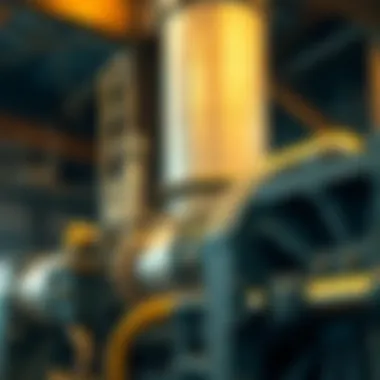
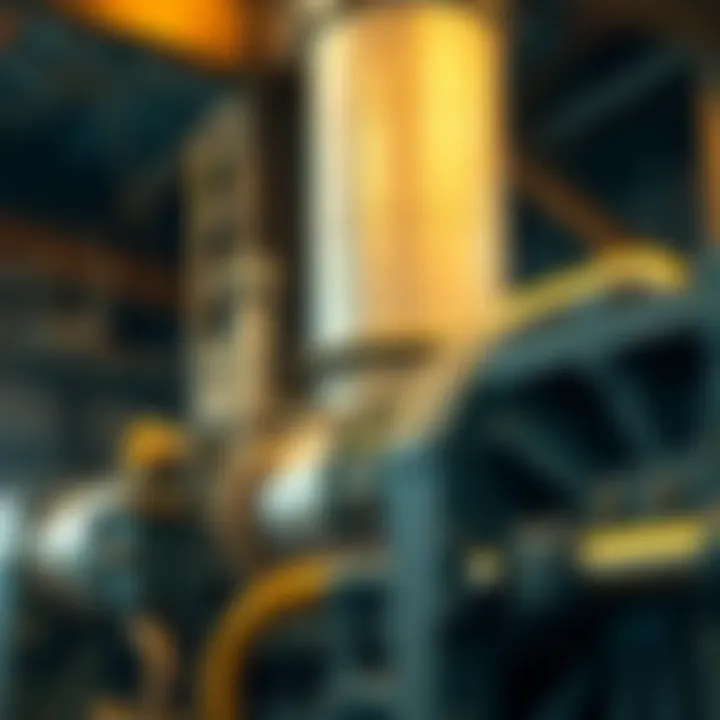
Intro
The landscape of cement manufacturing has undergone a significant transformation over the decades, with technologies evolving to meet the rigorous demands of modern construction. Among these advancements, the introduction of vertical mills has emerged as a game-changer in the cement industry. These mills offer not only operational efficiency but also align with the increasing focus on sustainability. As we dive into the essentials of vertical mills, it becomes clear how crucial they are in optimizing the manufacturing process and reducing environmental impact.
Understanding vertical mills is not merely about grasping their operational characteristics; it involves appreciating the range of benefits they provide over traditional grinding methods. In the forthcoming sections, we will dissect key terminology, explore findings from recent studies, and discuss the future of this technology. By doing so, we aim to equip readers—students, researchers, educators, and industry professionals—with a comprehensive understanding that goes beyond the surface.
So, let’s roll up our sleeves and examine how vertical mills have carved their niche in cement production, what lies ahead, and the innovations that could lead to further progress.
Preamble to Vertical Mills in Cement Production
Vertical mills play a pivotal role in cement manufacturing, marking a significant advancement in grinding technology. Their importance lies not just in improving efficiency but also in the ability to produce high-quality cement with a reduced environmental footprint. Unlike traditional methods, vertical mills allow for continuous operation and greater flexibility in handling various material types, which makes them a preferred choice in modern industrial settings.
Historical Context
To understand the significance of vertical mills, it's crucial to explore their origins and evolution within the cement production landscape. Initially, cement milling was a labor-intensive process using ball mills that required substantial energy input and time. Early developments in grinding technology emphasized basic milling techniques, which often resulted in inconsistencies in product quality.
The transition to vertical mills began in the late 20th century, driven by the need for enhanced efficiency and reduced operational costs. By the 1990s, vertical roller mills had established their presence, leading to improvements in the production of fine cement and contributing considerably to the cement industry's productivity. These machines not only optimize the use of energy but also minimize material waste, further solidifying their role in sustainable practices within the sector.
Vertical Mill Design Overview
The design of vertical mills sets them apart from their horizontal counterparts, contributing to their growing acceptance in the industry. Generally, vertical mills consist of a grinding table and a set of rollers that pulverize the material into a fine powder. Some key aspects of their design include:
- Compact Form Factor: Vertical mills take up less floor space compared to traditional mills, which is a critical consideration in modern factory layouts.
- Integrated Classifiers: Many vertical mills come equipped with built-in classifiers that separate fine material from coarser particles during the grinding process, enhancing operational efficiency.
- Flexibility: These mills can easily switch between different types of cement or raw materials, which is especially beneficial for companies looking to diversify their product offerings without extensive downtime.
The unique design not only allows for better energy efficiency but also enables the use of alternative materials in the cement production process, promoting a circular economy approach.
"In the race for sustainability and efficiency, vertical mills have emerged as a linchpin in the modern cement industry, driving innovations that are reshaping production processes."
This section serves as a foundation for understanding the mechanics of vertical milling and its relevance in the broader narrative of advancements in cement production technology. By delving into the history and the distinctive characteristics of vertical mills, the subsequent sections will explore their operational principles and advantages, leading into the innovations shaping the future of this essential industry.
Mechanics of Vertical Milling
Vertical mills represent a significant leap in the evolution of cement production, emphasizing efficiency and versatility. Understanding the mechanics of vertical milling is crucial for grasping their unique advantages over traditional methods. The intricate design and operation of these systems allow for different grinding approaches that can transform raw materials into fine powders essential for cement production. Here, we will delve into the various aspects of the mechanics involved and their implications for the industry.
Grinding Principle
The grinding principle of a vertical mill is fundamentally distinct from that of its horizontal counterparts. In the latter, grinding typically occurs through the movement of heavy steel balls agitating the material. On the other hand, vertical mills utilize a grinding bed approach. This is achieved through a pair of heavy rollers that applied immense pressure onto a plate that holds the raw materials.
The main advantage? Higher efficiency. By applying pressure from above, vertical mills can crush materials more effectively, reducing energy consumption significantly compared to traditional methods. This not only minimizes operational costs but also enhances productivity. The rollers’ vertical position allows them to operate continuously, leading to a smooth and uninterrupted grinding process.
In addition, vertical mills adapt quite well to different materials. Whether dealing with limestone or clay, they can efficiently prepare varieties of materials, making them indispensable in cement production.
"Innovative grinding mechanisms in vertical mills promote greater energy efficiency and material adaptability compared to conventional grinding setups."
Material Flow Dynamics
When we talk about material flow dynamics within vertical milling systems, we touch upon an intricate network that significantly impacts efficiency and final product quality. In vertical mills, the feed material is introduced at the top and flows downward due to gravity. As it moves through the grinding bed, it interacts closely with the rollers.
This dynamic ensures a constant feed rate, which is paramount for maintaining uniformity in the final product. The overall design facilitates a quick dissipation of fine particles, which are then separated from coarser material by classifiers. This aerodynamic sorting prevents undue wear on the rollers, enabling them to maintain their efficiency over lengthy operational spans.
Adjustments can be made to the airflow and separator speed to ensure optimal product consistency, thereby addressing challenges like segregation and material clumping. Moreover, the vertical configuration improves the dust collection process, contributing to a cleaner work environment within the mill.
In summary, understanding the mechanics of vertical milling not only reveals the sophisticated technology at play but also underscores its pivotal role in promoting more efficient, adaptable, and sustainable cement production methods.
Comparison with Horizontal Mills
In the landscape of cement production, understanding the differences between vertical mills and horizontal mills is critical. While both are designed for the same end product, they vary significantly in their operational methodology, efficiency, and cost-effectiveness. This section will focus on these distinctions, particularly highlighting efficiency metrics and cost implications that can affect decision-making in industrial applications.
Efficiency Metrics
The efficiency of vertical mills compared to their horizontal counterparts is often a focal point of discussion. Primarily, vertical mills exhibit a higher energy efficiency due to their unique design and operational mechanics. The grinding process relies on a combination of gravitational force and centrifugal force, which helps to optimize the crushing of materials.
- Energy Consumption: Vertical mills typically consume less energy. For instance, the power requirement for vertical mills can be up to 30% lower than that of horizontal mills, leading to significant savings in operational costs over time.
- Product Quality: Vertical mills have been shown to produce finer and more consistent particle sizes. This is largely due to the ability to adjust the grinding pressure and the lower volume of air that moves through the mill, leading to less dust generation.
- Throughput: With enhanced material flow dynamics, vertical mills can often achieve a higher throughput, thus maximizing production rates. This means they can handle larger volumes in shorter periods without compromising on the quality of the cement.
The benefits listed above can often make vertical mills the clear choice in environments where energy efficiency and product uniformity are paramount.


Cost Implications
When it comes to costs, the advantages of vertical mills are multi-faceted, influencing both initial investments and long-term operational expenses.
- Initial Investment: While vertical mills may have a higher upfront cost compared to horizontal mills, the long-term financial benefits often outweigh these initial expenses. Their reliable performance and lower energy consumption translate into less financial strain over time.
- Maintenance Costs: Maintenance for vertical mills tends to be less frequent and less intensive. The design involves fewer moving parts, which reduces wear and tear. This results in lower maintenance costs and downtime, an important consideration for industries operating on tight schedules.
- Operational Costs: Given the improved energy efficiency and lower maintenance needs, the operational costs of vertical mills are usually lower than those associated with horizontal mills over the lifecycle of the equipment. Moreover, with less energy required for grinding, companies can allocate more resources toward other operational needs.
Ultimately, the choice between vertical and horizontal mills extends beyond mere functionality—it's a comprehensive appraisal of how these machines align with financial strategies and sustainability goals. Companies heavily invested in cement production must understand these implications to harness the maximum benefits of their milling technology.
"Choosing the right milling technology is not just about preference; it’s about recognizing the economics of efficiency and sustainability in the cement industry."
Key Benefits of Vertical Mills
Vertical mills offer substantial advantages over traditional milling systems in cement manufacturing, making them increasingly favored in the industry. When examining the key benefits of vertical mills, two fundamental aspects arise: energy efficiency and the overall quality of the product produced. Both of these elements not only contribute to operational savings but also shape the future direction of cement production.
Energy Efficiency
One of the standout features of vertical mills is their impressive energy efficiency. Unlike their horizontal counterparts, vertical mills leverage gravity to assist with material processing. This design reduces the need for excessive power, translating to lower energy costs. Moreover, the layout often allows for direct energy usage in grinding rather than through intermediate steps, which is a common practice in horizontal arrangements.
Beyond just their efficient design, vertical mills are equipped with advanced technologies that enhance their energy-saving capabilities. Features like waste heat recovery systems are becoming popular. These systems can capture excess heat generated during milling processes and utilize it for heating raw materials, further decreasing demand on energy resources.
- Reduces electricity consumption: Statistics show that users of vertical mills can save up to 30% more energy than other milling systems.
- Lower operating costs: With less energy used, operating expenses see a significant decline, boosting overall profitability.
This energy efficiency results in a compelling case for companies looking to shrink their operational carbon footprints while maintaining productivity.
Quality of Product
The quality of cement produced through vertical milling processes is another crucial benefit that can’t be overlooked. The fine grinding capabilities of these mills ensure that the final product meets stringent quality standards. Since vertical mills facilitate higher fineness levels, this helps achieve the desired performance characteristics of modern cement types, which often require unique specifications.
- Superior homogeneity: The grinding action of vertical mills promotes uniformity in particle size, which is vital for ensuring consistency in the performance of cement. Improved particle distribution leads to enhanced strength in cement applications.
- Control over particle size: Vertical mills often allow for tighter control over the grind’s fineness, which is essential when producing specialized cements. This capability ensures that manufacturers can meet the evolving demands of the market.
The end result is that products generated from vertical mills not only cost-effectively satisfy market requirements but also provide stronger and more durable materials for construction.
"Driving energy efficiency and quality through vertical milling technology positions industries to not only save costs but also meet ambitious sustainability targets."
In summary, the clear benefits of vertical mills lie in their energy efficiency and product quality. These advantages potentially reshape cement manufacturing dynamics and cater to an industry trend focused on sustainable and high-quality production practices.
Environmental Considerations
Environmental concerns have become a central theme in the discourse surrounding cement production. As industries grapple with their ecological footprints, the need for sustainable practices has surged. In this context, vertical mills play a crucial role in minimizing the environmental impact of cement manufacturing.
The pressing issues surrounding climate change and pollution necessitate that modern cement production methods adopt environmentally friendly technologies. Vertical mills, with their innovative design and advanced engineering, are at the forefront of this movement. They not only enhance the efficiency of cement grinding but also substantially reduce energy consumption and the carbon emissions typically associated with traditional milling methods.
Reducing Carbon Footprint
Vertical milling technology contributes significantly to reducing the carbon footprint of the cement industry. Estimates suggest that cement production accounts for nearly 8% of global CO2 emissions. This staggering statistic underscores the urgency for effective solutions. Vertical mills contribute in several ways:
- Lower Energy Use: These mills are known for their energy efficiency, consuming less power compared to their horizontal counterparts. For instance, they can reduce energy requirements by up to 30%, translating into lower greenhouse gas emissions.
- Alternative Raw Materials: The design of vertical mills enables the use of alternative materials in clinker production, such as industrial by-products. This shift not only lessens the carbon dioxide emitted during production but also reduces the need for virgin materials, which often require extensive mining operations.
By leveraging these advantages, vertical mills play a fundamental role in fostering a greener future for the cement industry.
Waste Management Practices
Effective waste management practices in vertical mill operations are pivotal for minimizing environmental impact. Three key approaches are worth noting:
- Recycling of By-products: Vertical mills can facilitate the efficient use of by-products generated in the cement manufacturing process. For example, using fly ash or slag can repurpose waste into valuable inputs for cement production, significantly reducing landfill contributions.
- Minimizing Waste Generation: The continuous grinding process in vertical mills ensures a consistent feed, which minimizes waste generation. By optimizing the material flow, manufacturers can mitigate losses and promote a more sustainable cycle.
- Water Conservation: Traditional cement production often involves significant water use, especially in cooling processes. Vertical mills require less water, reducing the strain on freshwater resources.
Implementing these waste management strategies not only addresses environmental concerns but also promotes operational efficiency, ultimately benefiting the entire supply chain.
"Transitioning to vertical mills is not just a technical upgrade; it’s a step towards a more sustainable cement industry."
Through the integration of these practices, the cement sector can make significant strides toward environmental responsibility, paving the way for a more sustainable manufacturing landscape. By adopting vertical milling technology, companies not only enhance their production capabilities but also align themselves with global sustainability goals.
Current Technologies in Vertical Milling
The realm of vertical milling in cement production has rapidly transformed over the years, emphasizing the need to integrate modern technological advancements. This progress not only enhances operational efficiency but also positions companies to stay competitive in a challenging market. As we delve into current technologies, it's essential to understand how automation and the Internet of Things (IoT) play pivotal roles in shaping the future of cement milling.
Automation in Cement Mills
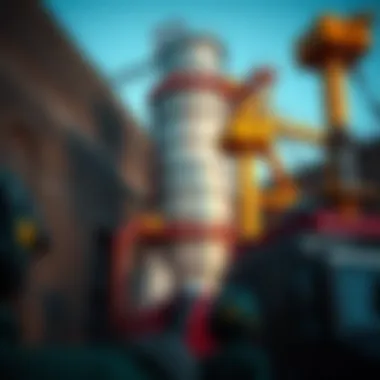
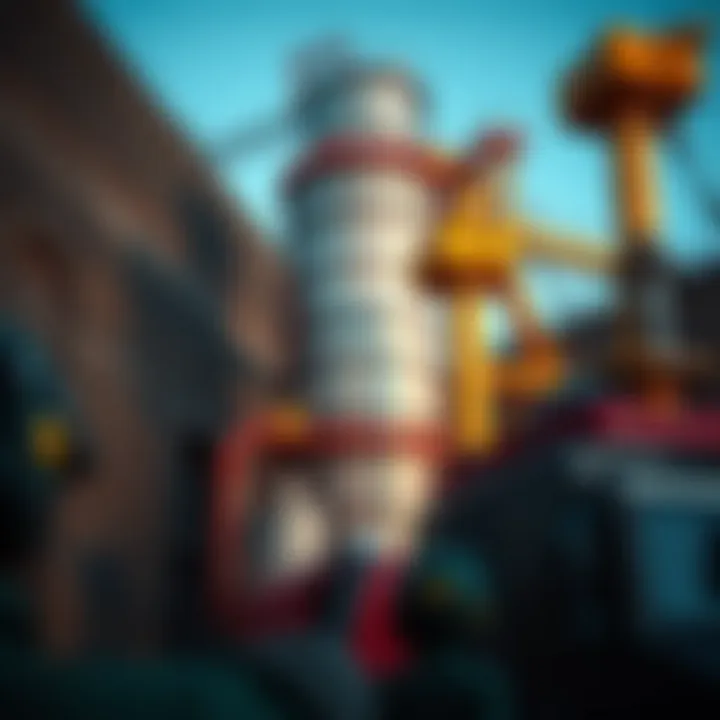
Automation in cement mills is revolutionizing the way production facilities operate. Automated systems minimize human intervention, thereby reducing errors and increasing throughput. Key benefits include:
- Consistency and Precision: Automated milling reduces variability in the grinding process, resulting in uniform product quality.
- Reduced Downtime: Predictive maintenance, powered by automation, helps in identifying equipment malfunctions before they escalate. This leads to less downtime and higher productivity.
- Data-Driven Decisions: Automation provides real-time data analytics, enabling mill managers to make informed decisions quickly. This data can relate to temperature, pressure, or the velocity of the milling components.
Implementing automated systems might require upfront investment, but the long-term savings that come from improved efficiencies make it a compelling case for many cement producers.
Integration of IoT
The Internet of Things offers an unprecedented level of connectivity and insight into cement milling operations. With interconnected machinery, sensors, and control systems, the IoT transforms how mills communicate and function. Main considerations include:
- Real-time Monitoring: IoT devices enable constant monitoring of machinery performance, providing critical data to optimize operations. For example, a sensor might detect fluctuations in temperature that could indicate potential issues.
- Enhanced Maintenance Practices: Maintenance can now transition from being reactive to predictive. For instance, IoT platforms can send alerts about equipment wear and tear, allowing for timely interventions that prevent significant breakdowns.
- Increased Energy Management: IoT systems can assist in tracking energy consumption, leading to better strategies for energy conservation.
"Embracing current technologies in vertical milling isn’t just about keeping up with industry standards; it’s about setting them."
For deeper insights into IoT applications, resources like Wikipedia and Britannica can be beneficial.
Future Trends in Cement Milling Technology
The landscape of cement milling technology is rapidly evolving, driven by a myriad of factors including environmental sustainability, efficiency, and technological advancements. The significance of understanding these trends cannot be overstated, as they directly impact not only the operational processes of cement production but also the industry's ability to adapt to regulatory pressures and market demands. Key elements such as sustainability innovations and focused research directions are reshaping how the industry perceives and implements cement milling.
Sustainability Innovations
Sustainability is no longer an afterthought in the cement industry; it has become a central tenet of operations. Innovations aimed at reducing the environmental impact of cement milling are burgeoning. For instance, developments in using alternative raw materials, such as fly ash and slag, are gaining traction. These materials not only enhance the quality of the cement produced but also lower the energy consumption associated with the milling process.
The adoption of energy-efficient vertical mills is another vital aspect. These mills utilize less energy compared to traditional grinding systems. Advanced monitoring systems, specifically designed to optimize energy use, are becoming commonplace. By incorporating sensors and data analytics, operators can significantly reduce energy waste while maintaining high production levels.
As we look towards the future, carbon capture technology is emerging as a game-changing solution. It captures CO₂ emissions from the milling process and stores it underground or repurposes it for other applications, effectively contributing to a circular economy.
"Sustainable practices in cement milling are not just beneficial for the environment, but also save costs in the long run."
Research Directions
Ongoing research in cement milling is equally crucial to advancing the industry. Focus areas are diverse, ranging from the development of smart materials to the integration of artificial intelligence in milling processes. For instance, researchers are exploring smart concrete, which can self-sense and heal cracks, reducing the need for repairs and, ultimately, enhancing the longevity of cement structures.
Investments in automation technology are also pivotal. Smart sensors and IoT-driven platforms can enable real-time data analysis, leading to improved milling efficiency and product quality. By adopting such technologies, plants can minimize downtime, optimize maintenance schedules, and reduce human error, all while increasing safety standards.
Moreover, the exploration of alternative energy sources, like solar and wind, to power cement milling operations is gaining momentum. Such avenues not only promise cost savings but can also harmonize with global goals for reduced carbon emissions. This is particularly relevant as markets increasingly demand low-carbon alternatives.
In summary, the future trends in cement milling technology underscore a transformation towards sustainable practices and innovative research that offers exciting possibilities for the industry's evolution. Embracing these changes will be essential for cement producers looking to thrive amid an ever-shifting landscape of regulations and consumer expectations.
As we stand at the crossroads of tradition and innovation, the industry must remain proactive in adopting new technologies and practices to ensure resilience and sustainability.
Industry Applications of Vertical Mills
The advent of vertical mills has revolutionized the cement industry, bringing notable changes in processing techniques and operational efficiencies. These mills are not just innovative machinery; they're essential tools for modern cement production. Spanning diverse types of cement processing, vertical mills have carved their space, offering advantages tailored to different applications.
Cement Types and Their Processing
Vertical mills are adept at processing various types of cement, including common varieties like Portland cement and specialized cements such as blended cements and slag cements. Notably, Portland cement, the most widely produced construction material, benefits from the vertical mill’s ability to finely grind clinker and other materials with high precision.
The processing of blended cements, for instance, utilizes vertical mills effectively to ensure uniform mixing and grinding of materials like fly ash or limestone with clinker. This method enhances the performance characteristics of the final product, such as reduced carbon emissions and improved durability.
Some beneficial points about cement types and their processing in vertical mills include:
- Consistency: The controlled environment of a vertical mill reduces variability in particle size, which is crucial for uniform cement quality.
- Versatility: Vertical mills can handle a mixture of different raw materials simultaneously, providing flexibility in production.
- Reduced Energy Use: The efficiency of vertical milling means lower energy consumption per ton of cement processed compared to traditional methods.
Case Studies in Implementation
Examining real-world implementations of vertical mills provides insightful lessons on their applications and benefits. One notable case is the use of vertical mills by a major cement manufacturer in Germany. This producer transitioned from traditional ball mills to vertical mills, achieving significant improvements in operational efficiency and product quality. The initial investment was substantial, yet in less than two years, the company reported an impressive 30% reduction in energy costs. This was not just a matter of switching machinery; it involved reengineering processes around the capabilities of vertical mills.
Another case is found in a Caribbean cement plant that adopted vertical milling technology to produce eco-friendly cement. By integrating alternative materials, such as industrial by-products, they were able to meet sustainable construction goals without sacrificing output or quality. The outcome was a nuanced balance between economic viability and environmental responsibility.
"The switch to vertical mills has become pivotal for cement producers - enhancing both performance and sustainability in an industry that greatly needs it."
In summary, the industry applications of vertical mills reflect a shift in approach towards more efficient and sustainable practices in cement production. This section underscores their paramount importance, showcasing how various cement types can be efficiently processed while highlighting successful implementations that serve as benchmarks for others within the sector.
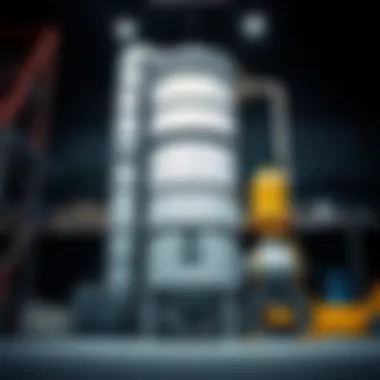
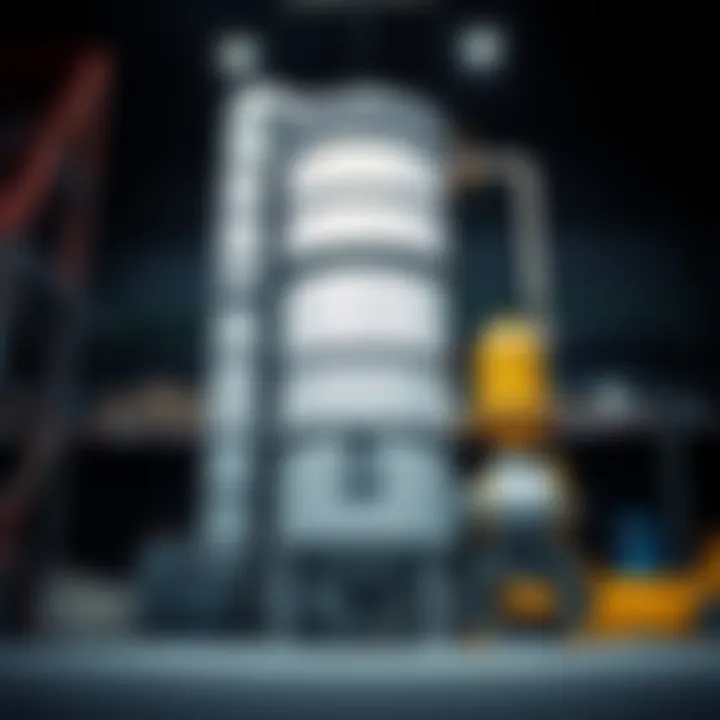
Challenges in Vertical Mill Operations
In the realm of cement manufacturing, vertical mills represent a leap forward in efficiency and output. However, as with any advanced technology, they come with their set of challenges that require careful consideration. Analyzing Challenges in Vertical Mill Operations is crucial for understanding their impact on productivity, cost-effectiveness, and overall operational health.
These challenges can affect not only the day-to-day functioning of the mill but also determine the plant's long-term viability. By addressing these issues, operators can optimize performance, reduce downtime, and ultimately result in more sustainable cement production practices.
Operational Disruptions
One of the foremost issues in the operation of vertical mills is the risk of operational disruptions. These disruptions can stem from various sources, including:
- Mechanical Failures: Bearings, gearboxes, and other critical components may fail due to wear or improper maintenance. For instance, a sudden gearbox failure can halt production, leading to significant financial loss due to downtime.
- Poor Material Quality: The quality of raw materials fed into the mill can directly influence its performance. Occasionally, if the material has excessive moisture or particles outside the required size, the mill can face clogs or inconsistent grinding.
- Energy Supply Issues: Given that vertical mills rely heavily on electricity, fluctuations in power supply can disrupt operations, causing intermittent grinding processes.
- Vibration Effects: High vibration levels can lead to stability issues, affecting grinding efficiency and even risking structural damage to the mill itself.
Addressing these operational disruptions requires a proactive approach that includes regular inspections, high-quality materials, and robust energy management practices. Operators must constantly monitor key performance indicators to anticipate and mitigate potential disruptions effectively.
Maintenance Considerations
Another layer of challenge in vertical mill operations lies in the maintenance requirements. Comprehensive maintenance strategies are vital to these systems' ongoing performance. Here are a few crucial aspects:
- Scheduled Maintenance: Regular inspections and scheduled maintenance can significantly reduce the risk of unexpected breakdowns. This can include replacing worn components and ensuring that lubrication systems are functioning correctly.
- Training and Skills Development: Staff training is essential for effective maintenance. Ensuring that technicians understand the specific needs and nuances of vertical mill systems will improve overall efficiency.
- Predictive Maintenance: Leveraging technologies like predictive analytics can help in identifying potential issues before they escalate into significant problems. For example, utilizing sensors to monitor vibration and temperature can alert maintenance crews to unusual behavior before a failure occurs.
- Inventory Management: Keeping an adequate supply of critical components on hand can help mitigate delays when maintenance is needed. An efficient inventory system allows for the quick replacement of parts, minimizing downtime.
Integrating a thoughtful and responsive maintenance culture ensures that the vertical mills function efficiently in their roles, thus enhancing the overall cement production process.
"Robust operational and maintenance strategies serve as the backbone of successful vertical mill operations, enabling companies to navigate challenges effectively."
Economic Impact of Vertical Mills on the Cement Industry
Vertical mills have reshaped the landscape of the cement industry significantly. Understanding the economic impact of these machines is crucial for stakeholders at different levels—from manufacturers and engineers to investors and regulatory bodies. The efficiency, cost savings, and productivity enhancements provided by vertical mills directly translate into competitive advantages, affecting pricing structures, market positioning, and, ultimately, profitability. Hence, grasping this topic allows for a more nuanced understanding of how the industry can navigate current challenges and opportunities.
Market Analysis
When we talk about market analysis in the context of vertical mills in cement production, several factors come into play. For starters, these mills tend to offer a higher degree of efficiency compared to traditional grinding systems. According to various industry reports, vertical mills consume significantly less energy on average, which positively impacts operating costs.
- Energy Savings: Traditional ball mills have been noted to require about 20-30% more energy relative to vertical mills.
- Production Capacity: Vertical mills can handle higher input materials, thus streamlining production. Plants equipped with vertical mills often report achieving output capacities of 300 tons per hour or more.
- Quality and Consistency: The ability of these mills to maintain uniformity in the fineness of the cement produced means less waste and higher product quality, enhancing market competitiveness.
Market demands for environmentally friendly production processes have also incentivized businesses to adopt vertical milling technology. The growing emphasis on ESG (Environmental, Social, and Governance) criteria means companies adopting sustainable practices can often command a premium for their products. This trend is reshaping market dynamics rapidly, causing many companies to pivot towards innovative technologies.
Investment Trends
Investment trends reflect the industry's understanding of the importance of innovation. In the last few years, there has been a noticeable increase in capital flow towards the development and upgrading of vertical mill technology. Here are some notable trends:
- Modernization Initiatives: Companies are investing heavily in retrofitting existing mills with advanced automation and control systems, enhancing operational efficiency. Projects that aim to modernize facilities often receive favorable financing options due to the predictable returns on investment.
- Research and Development: Firms are allocating resources to R&D efforts geared towards improving the milling process, often in partnership with universities and tech firms. Recent studies reported increases in investment by up to 15% in R&D for high-efficiency milling solutions.
- Diversification of Funding Sources: As the market for vertical milling grows, alternative funding sources such as venture capital are becoming more accessible. Many startups focusing on innovative cement technologies are finding it easier to attract investment, creating a more dynamic market.
In closing, the economic impact of vertical mills on the cement industry is profound. The combined benefits of efficiency, quality improvement, and the adaptability to modern market demands make these mills more than just an operational asset; they are pivotal to shaping the industry's future. Stakeholders who understand market dynamics and investment opportunities linked to vertical milling technologies position themselves favorably within this competitive landscape.
Key Takeaway: The future of cement production increasingly relies on vertical mills, as they are not only cost-effective but also essential for meeting quality and sustainability standards in a competitive marketplace.
Epilogue and Future Outlook
The significance of the conclusion and future outlook within this article cannot be overstated. It serves as a reflective summation of the insights gathered throughout our exploration of vertical mills in cement production. In an industry characterized by constant evolution and innovation, understanding both the current state and prospective advancements is crucial for stakeholders ranging from factory operators to policy-makers.
In this competitive landscape, vertical mills have emerged as pivotal components in cement manufacturing. Their ability to enhance energy efficiency, optimize material processing, and reduce environmental impact positions them as favorable choices. The conclusions drawn here encompass the advantages noted, such as reduced operational costs and improved product quality, and highlight the trends that are steering the future direction of mill technology.
"The future of the cement industry will be shaped by those who embrace technology and innovation, ensuring sustainability remains at the core of operations."
Summary of Findings
The findings distilled here present a robust case for the adoption and continued investment in vertical milling technology. Key takeaways include:
- Energy Efficiency: Vertical mills significantly lower energy consumption compared to traditional grinding methods.
- Higher Product Quality: The precision and control offered by vertical milling deliver finer, more homogeneous materials.
- Flexibility in Operations: These mills can accommodate various cement types, benefitting from their adaptable processing capabilities.
As seen throughout the article, vertical mills are not merely replacing older technologies but are indeed optimizing them, thus driving the entire industry forward.
Implications for Stakeholders
For stakeholders, the evolution and application of vertical mills carry both challenges and opportunities. Here are some of the implications:
- Investment in Technology: Firms need to consider investing not only in the mills themselves but also in training and development to maximize the benefits of automation and IoT integration.
- Regulatory Compliance: As environmental regulations tighten, understanding the operational impacts of vertical mills becomes crucial. Companies must ensure their practices remain compliant with evolving standards, which can hinge on sustainable practices leveraged through technology.
- Continuous Improvement Needs: Ongoing research and adaptation are necessary to unlock the full potential of vertical mills, particularly in terms of material processing innovations and environmental safety enhancements.
By recognizing these implications, stakeholders can strategically position themselves to harness the benefits of vertical milling technology, thereby solidifying their place in a rapidly transforming cement industry.
For further insights on cement production processes, explore resources such as National Cement or delve into technical research published on ResearchGate.
This comprehensive outlook solidifies the foundation laid in this article while pointing towards a future rich in potential for vertical mills within cement production.







